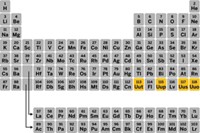Advertisement
Grab your lab coat. Let's get started
Welcome!
Welcome!
Create an account below to get 6 C&EN articles per month, receive newsletters and more - all free.
It seems this is your first time logging in online. Please enter the following information to continue.
As an ACS member you automatically get access to this site. All we need is few more details to create your reading experience.
Not you? Sign in with a different account.
Not you? Sign in with a different account.
ERROR 1
ERROR 1
ERROR 2
ERROR 2
ERROR 2
ERROR 2
ERROR 2
Password and Confirm password must match.
If you have an ACS member number, please enter it here so we can link this account to your membership. (optional)
ERROR 2
ACS values your privacy. By submitting your information, you are gaining access to C&EN and subscribing to our weekly newsletter. We use the information you provide to make your reading experience better, and we will never sell your data to third party members.
Physical Chemistry
Heavy Elements
International body dubs element 112 Copernicium
by Mitch Jacoby
March 1, 2010
| A version of this story appeared in
Volume 88, Issue 9
The periodic table officially has a new entry. The International Union of Pure & Applied Chemistry announced its approval last week of the name copernicium and symbol Cn for element 112 (Pure Appl. Chem., DOI: 10.1351/PAC-REC-09-08-20).
The approval follows IUPAC’s extensive review of claims made by the GSI Helmholtz Center for Heavy Ion Research, in Darmstadt, Germany, of being the first team to synthesize element 112. GSI’s claims date back to 1996. IUPAC’s announcement raises to six the total number of elements officially discovered and named by GSI.
GSI team leader Sigurd Hofmann explains that his team’s intention in selecting the name for element 112 is “to salute Nicolaus Copernicus, an influential scientist who didn’t receive any accolades in his own lifetime, and to highlight the link between astronomy and the field of nuclear chemistry.” Copernicus was the 16th-century Polish astronomer who developed the sun-centered model of the solar system—a radical departure from the thinking that prevailed in Copernicus’ day.
The Darmstadt researchers have previously been recognized for the discovery of five other elements, which they named bohrium (107), hassium (108), meitnerium (109), darmstadtium (110), and roentgenium (111).
Initially the team proposed Cp as the symbol for copernicium. But IUPAC did not approve that symbol principally because it had been used previously for element 71, lutetium, which, prior to 1949, was also known as cassiopeium.





Join the conversation
Contact the reporter
Submit a Letter to the Editor for publication
Engage with us on Twitter